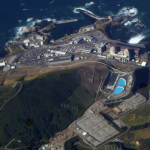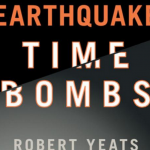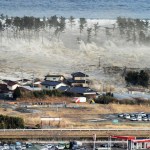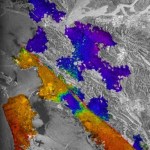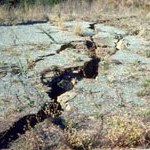earthquakes
This is bad news and good news, but mostly good news. No matter what you think of nuclear energy (and I'm one of those people who give it a stern look and remain suspicious), it does tend to produce electricity with the addition of much less fossil carbon into the atmosphere than, say, burning coal. So, we probably don't want to see a wholesale reduction in the use of nuclear energy too quickly, and we may even want to see some new plants built.
The Diablo Canyon nuclear plant is the only working nuke plant in California, and it is famously located in an earthquake-rich locality. The plant…
The Great San Francisco Earthquake(s)
On October 8th, 1865, the "Great San Francisco Earthquake" hit south of the city of San Francisco, magnitude 6.3.
On October 21st, 1868, the 'Great San Francisco Earthquake" hit near Haywards, east of the city, across the bay, magnitude 6.8.
On April 18th, 1906, the "Great San Francisco Earthquake" hit the Bay Area, magnitude 7.6.
The death tolls were unknown (but small), 30, and about 3,000, respectively.
Eighteen significant earthquakes happened after that (and five or so had happened between the first "great quakes") before February 9th, 1971, when…
"As seismologists gained more experience from earthquake records, it became obvious that the problem could not be reduced to a single peak acceleration. In fact, a full frequency of vibrations occurs." -Charles Francis Richter
You've all been around long enough to be familiar with the severe damage that earthquakes can cause, rattling and cracking the ground, shaking down buildings, and creating catastrophic tsunamis tidal waves. In short, the largest ones that occur in the wrong places will cause billions of dollars worth of damage and will kill thousands of people.
Image credit: AP /…
Even the best and brightest can get things wrong, which is why science depends on corroboration to get things right. On Respectful Insolence, Orac investigates the conviction of six Italian seismologists for failing to warn people about an earthquake that killed 300. Orac writes “‘earthquake swarms’ are not uncommon in the L’Aquila region” and “a medium-sized shock in a swarm forecasts a major event within several days only 2% of the time.” But for accurately assessing the risk of a major event, the government employees have been sentenced to six years in prison for manslaughter. On Starts…
Earthquakes are once again in the news, this time in Mexico. Although it is only the biggest quakes that make international headlines, we might take a minute to contemplate other quakes - the ones you'll never feel. So-called "slow" or "silent" earthquakes slip so softly they don't even show up on regular seismographic equipment.
As the name implies, slow quakes release the energy built up along the fault over hours or even days, as opposed to mere seconds for a fast, shaking quake. So why should we care about what happens in earthquakes that even scientists have barely noticed? For one…
By Dr. Friedemann Freund; Carl Sagan Center for the Study of Life in the Universe, SETI Institute, and Gail Jacobs
Friedemann Freund doesn't shrink from taking on the really big problems. His research has elucidated such important phenomena as the fact that rocks under stress behave like batteries that can produce currents deep within the crust of the Earth. These are not piddling electron flows, either - the currents could be as large as millions of amperes, sufficient to be measured above ground, and perhaps even from orbit. Understanding and exploiting this phenomenon could lead to a…
Greg Laden draws our attention to an object named Vesta, which by itself makes up 9% of the asteroid belt. Greg says "if you take the largest handful of objects in the asteroid belt, Ceres, Vesta, Pallas and 10 Hygiea, you've got half of the mass of the entire thing, according to the most current estimates." According to NASA, Vesta is even differentiated, meaning it was once hot enough to form a core, mantle, and crust. On Life at the SETI Institute, the Analysis Lead on NASA's Kepler project explains how to spot a planet from hundreds of millions of miles away. Dr. Jon Jenkins says "We…
The staggering 9.0 magnitude earthquake that struck off the coast of Japan March 11 sent a thirty foot tall tsunami raging up to six miles inland, with diminished waves reaching all the way to the Pacific Islands and the shores of North America. In Japan, thousands are dead, and the devastation is stunning. On Thoughts from Kansas, Josh Rosenau reflects that due Japanese diligence may have spared millions of lives, noting "the earthquake in Haiti last year, which was 100 times weaker, killed 230,000." On Observations of a Nerd, Christie Wilcox recounts her experience in Hawaii, from…
There's a great, new online news article by Science's Richard Kerr about the role of the Zipingpu Dam in last year's Wenchuan earthquake. A new article in Geophysical Research Letters (which I haven't read - my library doesn't have access to GRL) tests the plausibility of water as a trigger for the Wenchuan quake, and concludes that the weight of the water, combined with its penetration into the fault zone, might have made the difference.
There have been a number of studies in the past decade or so that suggest that earthquakes can be triggered by little things, such as the passage of…
Go to Dave's Landslide Blog for full details about this. I don't have access to the paper.
According to Dave Petley, there's a new paper in Nature Geoscience about the Slumgullion landslide. Slumgullion is in my greater neighborhood - it's in Colorado's San Juan Mountains, between Lake City (former home of Alferd Packer) and Creede (former home of Doc Holliday), and I think it's got the coolest name of any landslide (and possibly the coolest name of any geological feature). It's a strange landslide for its slow movement, and it's being monitored in excruciating detail by the US Geological…
There's a lot going on the online geo-world tomorrow. It's Blog Action Day, and the subject is Climate Change. It's Earth Science Week's first Women in Geoscience day. And, at 10:15 am Pacific time, it's California's second annual earthquake drill - the Shake Out.
I don't live in California, but I might crawl under my desk tomorrow morning just to be part of the action. Because there's a big anniversary coming up on Saturday, and I'll be busy in Portland, Oregon, without the time to post.
At 5 pm on Tuesday, October 17, 1989, I was just settling down to do my Chinese homework. (Yes, I had…
Hey everyone: here's the coolest news in the world! My colleague and friend, Chris Rowan was interviewed streaming (and live) by BBC News radio and television on their program, World, Have Your Say [1 October, 1305-1400 EDT]. The interviewer investigated the (lack of) predictability of natural disasters, especially earthquakes and tsunamis. If you missed the program, it is now available here, for only the next seven days, so download it to your ipod now or stream it.
Hey everyone: here's the coolest news in the world! My colleague and friend, Chris Rowan is being interviewed streaming (and live) by BBC News radio and television on their program, World, Have Your Say [1300-1400 EDT], and the topic will investigate the (lack of) predictability of natural disasters, especially earthquakes and tsunamis. Go there now to hear him (and live blog it, too).
This morning, the California Supreme Court will announce its decision on whether or not a slim 50% majority can amend the state constitution in order to specifically deny a previously-recognized constitutional right. It will also determine the fate of the 18,000 same-sex marriages performed last year, between the state Supreme Court's decision that same-sex marriage was a constitutional right in California, and the passage of Proposition 8. The New York Times quotes one man whose marriage is currently in legal limbo:
“The 18,000 marriages will be evidence that California is not going to fall…
One year ago today, a M 7.9 earthquake struck the Chinese province of Sichuan. It was horrific. I don't have anything profound or helpful to say about it myself, but I want to pass on links to other remembrances:
Berkeley SeismoBlog explains the tectonics of the earthquake, and the possibility (raised in the Chinese journal Geology and Seismology that the water in the Zipingpu Reservoir may have triggered the earthquake. (The plate movements caused it, but the water may have made it easier for the fault to slip.)
The NPR reporters who were in Chengdu last May for another story, only to find…
I've been awakened by an earthquake, but it was only M 4. I can't imagine what it would have been like to be in San Francisco 103 years ago this morning, when a M 8-ish earthquake struck at 5:12 am. Shaking ten times stronger than the Loma Prieta earthquake - I couldn't stand up in M 7 quake; would a M 8 knock a person out of bed?
And it was one thing to experience a M 7 earthquake in the daytime, as a geologist who knew just how nearby the Pacific Plate was, and how fast it moved, and what it could do. Did people in 1906 remember the Hayward quake of 1868, nearly 40 years before? Or would…
Along with the stories of tragedy in Italy, there are also stories that the earthquake was predicted, and that the predictions were ignored. Was the tragedy made even worse by authorities who wouldn't listen to a scientist who knew what he was talking about?
Now, I'm not a seismologist, but I know a little about predicting earthquakes. I predicted one, you see: the 1989 Loma Prieta earthquake.
There had been a small earthquake just before I arrived at Stanford, so earthquakes were on a lot of people's minds. The San Francisco Examiner had a hilarious cartoon about how to use your pet to…
The question of whether or not I am a geologist is not just an amusing exercise in academic politics. In Washington, as in most U.S. states, geology is a regulated profession; guidelines for who can and cannot call themselves a geologist in a professional context are laid out in the administrative code and enforced by the Geologist Licensing Board.
I am not a geologist, nor will I become one any time soon. To comply with Washington law, I would need to complete coursework in the core subjects of geology (as specified in WAC 308-15-040: structural geology, mineralogy, petrology and sedimentary…
On Monday, airline passengers were the first to observe the eruption of the just-barely-above-the-water volcano that forms the islands of Hunga Tonga and Hunga Ha'apai, in Tonga. Three days later, a magnitude 7.9 earthquake occurred on the Tonga trench.
Was the timing of these two events just coincidence?
Yes.
Why do I think the events were unrelated? Well:
Earthquakes happen all the time. Thankfully for Tongan residents, I am using a geological definition of "time" here, but still: A major earthquake on a major plate boundary does not require any special explanation.
The earthquake was a…
On Monday, airline passengers were the first to observe the eruption of the just-barely-above-the-water volcano that forms the islands of Hunga Tonga and Hunga Ha'apai, in Tonga. Three days later, a magnitude 7.9 earthquake occurred on the Tonga trench.
Was the timing of these two events just coincidence?
Yes.
Why do I think the events were unrelated? Well:
Earthquakes happen all the time. Thankfully for Tongan residents, I am using a geological definition of "time" here, but still: A major earthquake on a major plate boundary does not require any special explanation.
The earthquake was a…
